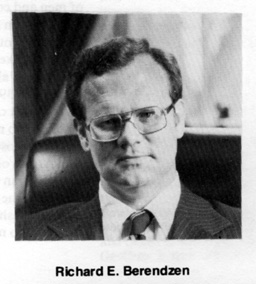|
Time and a Cosmic Perspective
By: Richard Berendzen
A random sample of COSMIC SEARCH readers responded to a recent questionnaire that, of the articles they liked, this one by Dr. Richard Berendzen was one of the very best. We reprint it here as it appeared in the premier issue of COSMIC SEARCH. Dr. Berendzen is a member of the Editorial Board of COSMIC SEARCH. Now President of the American University, he was Provost when this article appeared. — Ed.
Time. We kill time, spend time, lose time, make time, beat time, take time, waste time; but we virtually never consider time, much less understand it. Yet to view events properly and possibly even to perceive ourselves in rightful context, let us go back in time, even to its beginning.
For countless ages there truly was darkness on the face of the deep. Then, some 18 billion years ago, a cataclysmic explosion brought forth the cosmos itself. This was the birth of the universe. Even today we live in the lingering remnant of the radiation produced by that titanic blast. Some billions of years after the explosion, large ensembles of material clumped because of their mutual attraction. And so the protogalaxies were born. In those early galaxies, some of the gas and dust congealed by its own gravity to form large, amorphous, spherical balls, which slowly shrank and ultimately flickered into light. And so the stars were born. In the hearts of those stars, nuclear furnaces raged. In a form of stellar alchemy, hundreds of millions of tons of hydrogen were converted into helium every second. And so they have burned for all these billions of years.
"Without astronomy we could not understand this epic, this cosmic perspective."
As the stars formed, debris was left behind. Some of it became planetary systems around the stars. On some of those planets there must have been early atmospheres, perhaps similar to the earth's in its primordial days. In some of those atmospheres there must have been the very chemicals that brought forth life here. All current evidence compellingly suggests that the same processes that operated here might well have operated elsewhere, possibly thousands or millions or even hundreds of millions of times. If so, life may have flickered into existence on those planets, and some of that life may have been intelligent.
Billions of years went by, with galaxies forming and stars burning, expanding, exploding, shrinking, collapsing, dying. Then, some five billion years ago, on the remote periphery of an average galaxy in an unexceptional part of the universe, a particular star was born. On piece of debris number 3, special events were to take place; several billion years later the chemical and biological processes of that young planet's atmosphere and oceans yielded a strange new apparition —Homo sapiens, man.
After more eons elapsed, man evolved, creating societies and civilizations and education and nations and war and peace and law and science and technology and our modern world. And here we are in the year marked in time as 1979.
In such a cosmic sweep through space and time, any rational person must feel an almost overpowering smallness. Our day-to-day concerns and trite prejudices shrink into microscopic, infinitesimal nothingness.
Yet there is another side, and it gives dignity and worth to life itself. For even though our physiques are but specks in space and our life-spans but ticks in time, we nonetheless are capable of comprehending a system far vaster than ourselves. Our ethical and moral concerns, together with this ability, constitute some of the most ennobling characteristics of humankind.
Without astronomy we could not understand this epic, this cosmic perspective. And it is worth knowing.

 Richard E. Berendzen was born in Walters, Oklahoma, in 1938. He received a Ph.D. degree from Harvard in 1967. Joining the physics faculty at Boston University, he became department chairman in 1971. Three years later he went to the American University, Washington, D.C., where he is now University Provost. Dr. Berendzen is the author of several books including "Man Discovers the Galaxies" (1975). Currently he is a member of the Editorial Board of COSMIC SEARCH.
Richard E. Berendzen was born in Walters, Oklahoma, in 1938. He received a Ph.D. degree from Harvard in 1967. Joining the physics faculty at Boston University, he became department chairman in 1971. Three years later he went to the American University, Washington, D.C., where he is now University Provost. Dr. Berendzen is the author of several books including "Man Discovers the Galaxies" (1975). Currently he is a member of the Editorial Board of COSMIC SEARCH.
Dr. Berendzen believes that science fact, if presented well, can be far more engaging than science fiction. He feels that there is a tremendous need to make more people aware of the difference between real science and blatant pseudo-science.
This piece appeared at the conclusion of a longer article "Out of Sight." Reprinted by permission from THE AMERICAN SCHOLAR, Vol. 46, No. 4, Autumn 1977. Copyright ©1977 by the United Chapters of Phi Beta Kappa.
|
![[NAAPO Logo]](../../Images/NAAPOsm.jpg)
![[NAAPO Logo]](../../Images/NAAPOsm.jpg)